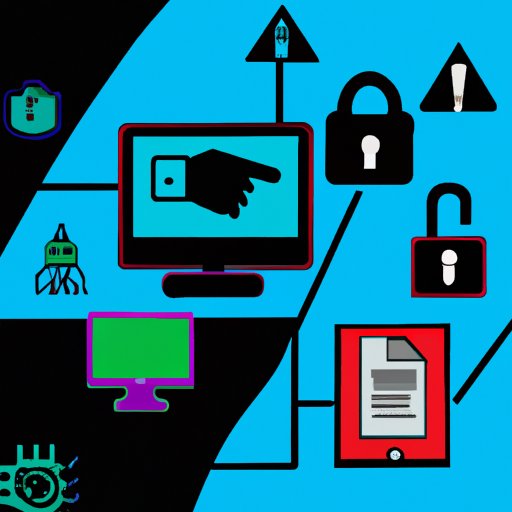Introduction
Cybersecurity is becoming increasingly important in the world today. As businesses and individuals rely more heavily on technology, they must ensure their data is properly protected against malicious attacks. The best way to do this is to set up a cybersecurity lab, which will allow you to test out different security measures and develop strategies to protect your data.
Overview of the Need for Cybersecurity Labs
A cybersecurity lab is a dedicated space where you can create a simulated environment to test the security of your system. It allows you to explore different types of threats and vulnerabilities in order to develop better security measures. By using a lab, you can identify potential risks before they become an issue and develop proactive strategies to protect your data.
The primary purpose of a cybersecurity lab is to provide a safe environment for testing and development of security protocols. It allows you to test different methods of protection without risking your actual systems. You can also use the lab to learn new techniques and explore emerging technologies to stay ahead of the curve when it comes to cybersecurity.

Benefits of Building Your Own Cybersecurity Lab
Building your own cybersecurity lab has many benefits. First, it gives you the ability to experiment with different security measures and protocols without risking your actual systems. This allows you to develop more effective security strategies that are tailored to your specific needs. Additionally, having a lab allows you to quickly respond to security incidents and investigate any potential threats.
Another benefit of having a lab is that it can be used as an educational resource. You can use it to teach others about cybersecurity and how to protect themselves from various threats. You can also use the lab to share information and collaborate with other security professionals.
Outlining the Necessary Hardware and Software for a Cybersecurity Lab
In order to set up a successful cybersecurity lab, you’ll need to have the right hardware and software in place. This includes desktops, laptops, servers, network devices, and other equipment, as well as operating systems, security software, and tools.
Desktops, Laptops, Servers, Network Devices, and Other Equipment
The first step in setting up your lab is to choose the right hardware. Desktops and laptops are essential for running simulations and analyzing data. You should also consider investing in server hardware if you plan on hosting web applications or services. Additionally, you may want to purchase network devices such as routers, switches, and firewalls to simulate realistic scenarios.
Other pieces of hardware you may want to include in your lab are storage devices, such as hard drives and USB sticks, and peripherals, such as keyboards, mice, and printers. Finally, you may want to invest in specialized equipment, such as virtualization software and cloud computing services, to further expand the capabilities of your lab.
Operating Systems, Security Software, and Tools
Once you have the necessary hardware in place, you’ll need to install the appropriate software. This includes operating systems, such as Windows, macOS, and Linux, as well as security software, such as antivirus programs, password managers, and encryption tools. Additionally, you’ll need to install various tools, such as traffic analyzers, vulnerability scanners, and intrusion detection systems.
You should also consider installing virtualization software, such as VMware or VirtualBox, to create multiple virtual machines within your lab. This will allow you to create different environments for testing and experimenting with different security measures.

Exploring the Different Types of Cybersecurity Labs
There are several different types of cybersecurity labs, each of which has its own unique purpose. Here are some of the most common types of labs:
Penetration Testing Lab
A penetration testing lab is designed to simulate real-world attacks. It allows you to identify vulnerabilities in your system and develop strategies to protect against them. This type of lab typically includes a variety of tools, such as port scanners, vulnerability scanners, and network mappers.
Digital Forensics Lab
A digital forensics lab is used to analyze digital evidence. It allows you to investigate data breaches and other security incidents. The lab typically includes tools, such as disk imaging software, hash verification programs, and forensic analysis software.
Malware Analysis Lab
A malware analysis lab is used to examine malicious software. It allows you to identify the source of the malware and develop strategies to protect against it. The lab typically includes tools, such as sandboxing software and malware reverse engineering tools.
Network Security Lab
A network security lab is used to test the security of a network. It allows you to identify weaknesses and develop strategies to protect against them. The lab typically includes tools, such as packet sniffers, port scanners, and intrusion detection systems.
Providing Tips for Setting Up a Secure Cybersecurity Lab
When setting up your cybersecurity lab, it’s important to take steps to ensure it is secure. Here are some tips to help you do so:
Physical Security
It’s important to make sure the lab is physically secure. This means ensuring the lab is located in a secure area, limiting access to those who need it, and using locks and other security measures to protect the equipment.
Logical Security
It’s also important to make sure the lab is logically secure. This means using strong passwords and two-factor authentication for all accounts, encrypting all data, and using firewalls and other security measures to protect the network.
Monitoring Activity
Finally, it’s important to monitor the activity in the lab. This means tracking all user activity, logging all changes, and using intrusion detection systems to detect any suspicious activity.

Introducing Tools and Resources That Can Help You Build Your Cybersecurity Lab
There are a number of tools and resources available that can help you build your cybersecurity lab. Here are some of the most popular ones:
Open Source Software
There are a number of open source software programs available for use in a cybersecurity lab. These include Nmap for network mapping, Metasploit for penetration testing, and Wireshark for network traffic analysis.
Commercial Products
There are also a number of commercial products available for use in a cybersecurity lab. These include Kali Linux for penetration testing, Splunk for log analysis, and AlienVault for threat detection.
Online Communities
Finally, there are a number of online communities dedicated to cybersecurity. These include forums, mailing lists, and IRC channels where you can ask questions and get advice from experienced security professionals.
Conclusion
Setting up a cybersecurity lab can be a daunting task, but it’s essential for protecting your data. By outlining the necessary hardware and software, exploring the different types of labs, providing tips for setting up a secure lab, and introducing tools and resources that can help you build your lab, you can ensure your lab is properly equipped to protect your data.
(Note: Is this article not meeting your expectations? Do you have knowledge or insights to share? Unlock new opportunities and expand your reach by joining our authors team. Click Registration to join us and share your expertise with our readers.)
